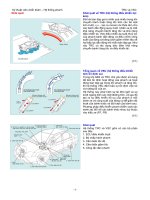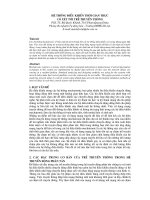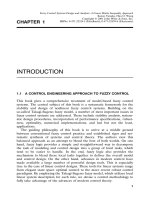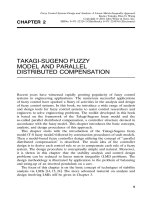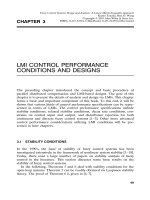Tài liệu Hệ thống điều khiển mờ - Thiết kế và phân tích P6 pptx
Bạn đang xem bản rút gọn của tài liệu. Xem và tải ngay bản đầy đủ của tài liệu tại đây (109.11 KB, 12 trang )
Fuzzy Control Systems Design and Analysis: A Linear Matrix Inequality Approach
Kazuo Tanaka, Hua O. Wang
Copyright ᮊ 2001 John Wiley & Sons, Inc.
Ž. Ž .
ISBNs: 0-471-32324-1 Hardback ; 0-471-22459-6 Electronic
CHAPTER 6
OPTIMAL FUZZY CONTROL
In control design, it is often of interest to synthesize a controller to satisfy, in
an optimal fashion, certain performance criteria and constraints in addition
to stability. The subject of optimal control addresses this aspect of control
system design. For linear systems, the problem of designing optimal con-
Ž.
trollers reduces to solving algebraic Riccati equations AREs , which are
usually easy to solve and detailed discussion of their solutions can be found
wx
in many textbooks 1 . However, for a general nonlinear system, the optimiza-
Ž.
tion problem reduces to the so-called Hamilton-Jacobi HJ equations, which
Ž.wx
are nonlinear partial differential equations PDEs 2 . Different from their
counterparts for linear systems, HJ equations are usually hard to solve both
numerically and analytically. Results have been given on the relationship
between solution of the HJ equation and the invariant manifold for the
Hamiltonian vector field. Progress has also been made on the numerical
wx
computation of the approximated solution of HJ equations 3 . But few
results so far can provide an effective way of designing optimal controllers for
general nonlinear systems.
In this chapter, we propose an alternative approach to nonlinear optimal
control based on fuzzy logic. The optimal fuzzy control methodology pre-
wx
sented in this chapter is based on a quadratic performance function 4᎐7
utilizing the relaxed stability conditions. The optimal fuzzy controller is
designed by solving a minimization problem that minimizes the upper bound
of a given quadratic performance function. In a strict sense, this approach is
a suboptimal design. One of the advantages of this methodology is that the
wx
design conditions are represented in terms of LMIs. Refer to 8 for a more
thorough treatment of optimal fuzzy control.
109
OPTIMAL FUZZY CONTROL
110
6.1 QUADRATIC PERFORMANCE FUNCTION
AND STABILIZING CONTROL
The control objective of optimal fuzzy control is to minimize certain perfor-
mance functions. In this chapter, we present a fuzzy controller design to
minimize the upper bound of the following quadratic performance function
Ž.
6.1 :
ϱ
TT
J s y t Wy t q u t Ru tdt,6.1
Ä4
Ž. Ž. Ž. Ž. Ž .
H
0
where
r
y t s h z t Cx t .
Ž. Ž. Ž.
Ž.
Ý
ii
i
s1
The following theorem presents a basis to the optimal fuzzy control
problem. The set of conditions given herein, however, are not in terms of
LMIs. The LMI-based optimal fuzzy control design will be addressed in the
next section.
Ž. Ž.
THEOREM 24 The fuzzy system 2.3 and 2.4 can be stabilized by the PDC
Ž.
fuzzy controller 2.23 if there exist a common positi®e definite matrix P and a
common positi®e semidefinite matrix Q satisfying
0
U q s y 1 Q - 0 6.2
Ž. Ž.
ii 3
V y 2Q - 0, i - j s.t. h l h /
,6.3
Ž.
ij 4 ij
where s ) 1,
T
A y BF P
Ž.
iii
TT
C yF
ii
ž/
qPAy BF
Ž.
iii
U s ,6.4
Ž.
ii
y1
C yW 0
i
y1
yF 0 yR
i
T
A y BF P
Ž.
iij
qPAy BF
Ž.
iij
TTTT
C yFCyF
ijji
T
q A y BF P
Ž.
jji
0
qPAy BF
Ž.
jji
V s ,6.5
Ž.
ij
y1
C yW 000
i
y1
yF 0 yR 00
j
y1
C 00yW 0
j
y1
yF 000yR
i
QUADRATIC PERFORMANCE FUNCTION AND STABILIZING CONTROL
111
Q 00
Q s block-diag ,
Ž.
0
3
Q 0000
Q s block-diag .
Ž.
0
4
Then, the performance function satisfies
J - x
T
0 Px 0,
Ž. Ž.
T
Ž. Ž.
where x 0 Px 0 acts as an upper bound of J.
Proof. Let us define the following new variable
r
C
y t
Ž.
i
y t ssh z t x t .
Ž. Ž. Ž.
Ž.
ˆ
Ý
i
yF
u t
Ž.
i
i
s1
Ž.
Equation 6.1 can be rewritten as
ϱ
W 0
T
J s y t y tdt.
Ž. Ž.
ˆˆ
H
0 R
0
Assume that there exists a common positive definite matrix P and a common
Ž. Ž.
positive semidefinite matrix Q satisfying 6.2 and 6.3 . Then, from Schur
0
complements, we have
T
A y BF Pq PAy BF q s y 1 Q
Ž.Ž.Ž.
iii iii 0
W 0 C
i
TT
q C yF - 0 6.6
Ž.
ii
0 R yF
i
and
T
A y BF Pq PAy BF
Ž.Ž.
iij iij
T
q A y BF Pq PAy BF y 2 Q
Ž.Ž.
jji jji 0
W 0 C
i
TT
q C yF
ij
0 R yF
j
W 0 C
j
TT
q C yF - 0.6.7
Ž.
ji
0 R yF
i
Ž. Ž.
From 6.6 and 6.7 , we obtain
T
A y BF Pq PAy BF q s y 1 Q - 0 6.8
Ž.Ž.Ž. Ž.
iii iii 0
OPTIMAL FUZZY CONTROL
112
and
T
A y BF Pq PAy BF
Ž.Ž.
iij iij
T
q A y BF Pq PAy BF y 2 Q - 0.6.9
Ž.
Ž.Ž.
jji jji 0
It is clear from Theorem 9 in Chapter 3 that the fuzzy control system is
Ž. Ž.
globally asymptotically stable if 6.2 and 6.3 hold.
Next, it will be proved that the quadratic performance function satisfies
T
Ž. Ž.
T
Ž. Ž.
J - x 0 Px 0 . Consider a Lyapunov function candidate x t Px t . Then,
Ž.Ž.
from 6.6 , 6.7 , and the Appendix,
d
T
x t Px t
Ž. Ž.
dt
s x
T
t Px t q x
T
t Px t
Ž. Ž. Ž. Ž.
˙˙
rr
T
T
s h z thz t x t A y BF Pq PAy BF x t
Ž. Ž. Ž. Ž.
Ž.Ž.
Ž.Ž.
ÝÝ
½5
ij iij iij
i
s1 js1
r
T
2 T
s h z t x t A y BF Pq PAy BF x t
Ž. Ž.Ž . Ž . Ž.
Ž.
Ä4
Ý
iiiiiii
i
s1
r
T
T
q h z thz t x t A y BF Pq PAy BF x t
Ž. Ž. Ž. Ž.
Ž.Ž.
Ž.Ž.
ÝÝ
½5
ij iij iij
i
s1 i/j
r
T
2 T
- h z t x t A y BF Pq PAy BF x t
Ž. Ž.Ž . Ž . Ž.
Ž.
Ä4
Ý
iiiiiii
i
s1
r
W 0 C
i
TTT
y x thz thz t C yF
Ž. Ž. Ž.
Ž.Ž.
ÝÝ
ij ij
½
0 R yF
j
i
s1 i-j
r
W 0 C
j
TT
q h z thz t C yFxt
Ž. Ž. Ž.
Ž.Ž.
ÝÝ
ij ji
5
0 R yF
i
i
s1 i-j
r
T
q 2 h z thz t x t Qxt
Ž. Ž. Ž. Ž.
Ž.Ž.
ÝÝ
ij 0
i
s1 i-j
r
W 0 C
i
T 2 TT
- yx thz t C yFxt
Ž. Ž. Ž.
Ž.
Ý
iii
½5
0 R yF
i
i
s1
r
W 0 C
i
TTT
yx thz thz t C yF
Ž. Ž. Ž.
Ž.Ž.
ÝÝ
ij ij
½
0 R yF
j
i
s1 i-j
QUADRATIC PERFORMANCE FUNCTION AND STABILIZING CONTROL
113
r
W 0 C
j
TT
q h z thz t C yFxt
Ž. Ž. Ž.
Ž.Ž.
ÝÝ
ij ji
5
0 R yF
i
i
s1 i-j
r
2 T
y s y 1 h z t x t Qxt
Ž . Ž. Ž. Ž.
Ž.
Ý
i 0
i
s1
r
T
q2 h z thz t x t Qxt
Ž. Ž. Ž. Ž.
Ž.Ž.
ÝÝ
ij 0
i
s1 i-j
r
W 0 C
i
T 2 TT
Fyx thz t C yFxt
Ž. Ž. Ž.
Ž.
Ý
iii
½5
0 R yF
i
i
s1
r
W 0 C
j
TTT
y x thz thz t C yF
Ž. Ž. Ž.
Ž.Ž.
ÝÝ
ij ij
½
0 R yF
i
i
s1 i-j
r
W 0 C
i
TT
q h z thz t C yFxt
Ž. Ž. Ž.
Ž.Ž.
ÝÝ
ij ji
5
0 R yF
j
i
s1 i-j
r
2 T
y s y 1 h z t x t Qxt
Ž . Ž. Ž. Ž.
Ž.
Ý
i 0
i
s1
r
T
q 2 h z thz t x t Qxt
Ž. Ž. Ž. Ž.
Ž.Ž.
ÝÝ
ij 0
i
s1 i-j
rr
C
j
W 0
TTT
syx thz thz t C yFxt
Ž. Ž. Ž. Ž.
Ž.Ž.
ÝÝ
ij ii
½5
0 R yF
j
i
s1 js1
rr
2 T
y s y 1 h z t y 2 h z thz t x t Qxt
Ž . Ž. Ž. Ž. Ž. Ž.
Ž. Ž.Ž.
ÝÝÝ
iij0
ž/
i
s1 is1 i-j
rr
C
i
W 0
TTT
syx thz t C yF h z t x t
Ž. Ž. Ž. Ž.
Ž. Ž.
ÝÝ
iii i
½5
ž/
ž/
0 R yF
i
i
s1 is1
rr
2 T
y s y 1 h z t y 2 h z thz t x t Qxt
Ž . Ž. Ž. Ž. Ž. Ž.
Ž. Ž.Ž.
ÝÝÝ
iij0
ž/
i
s1 is1 i-j
W 0
T
syy t y t
Ž. Ž.
0 R
rr
2 T
y s y 1 h z t y 2 h z thz t x t Qxt
Ž . Ž. Ž. Ž. Ž. Ž.
Ž. Ž.Ž.
ÝÝÝ
iij0
ž/
i
s1 is1 i-j
W 0
T
Fyy t y t .
Ž. Ž.
0 R
